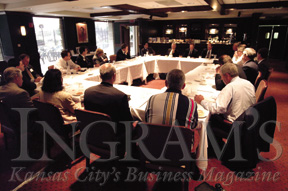
Participants Include:
Jim Devine, Lee’s Summit Economic Development Council
Phil Tate, Missouri Department of Economic Development
Senator Harry Wiggins, Blackwell Sanders Peper Martin
Michelle Sweeney, Ingram’s Magazine
Henry Rizzo, Missouri House of Representatives
Mayor Rondell Stewart, City of Independence
Fran Owens, Blue Springs Dept. of Economic Development
Jim Harpool, Dial Realty of Kansas City Inc.
Mayor Harry Wilson, City of Grandview
Tim Underwood, Home Builders Assn. of Greater Kansas City
Dennis Watley, Kansas City Chiefs
Greg Martinette, Grandview Area Economic Development Council
Joe Sweeney, Ingram’s Magazine
Rich Muller, Summit Technology Campus/Townsend Capital
Jeff Pinkerton, Mid-America Regional Council
Bruce Peshoff, Planning Works
David Gale, Gale Communities
Jacob DiPietre, Office of Congressman Sam Graves
Tom Riederer, Independence Council for Economic Development
Mark Martin, Space Center
Jack Craft, Craft, Fridkin & Rhyne
There could be no more appropriate place for a gathering of the economic development elite of Jackson County than the friendly confines of the Arrowhead Club at the Harry S. Truman Sports Complex. Since its opening 30 years ago, the twin-stadium complex has emerged as something of a center point for a county that did not previously have one. Given its pivotal location near the intersection of I-70 and I-435, the complex also suggested that the future of Jackson County lay as much to the relatively undeveloped east as to the west, a future that has since come to pass.
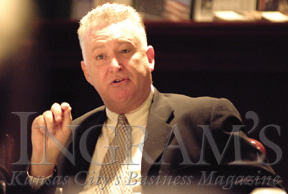
Missouri Rep. Henry Rizzo discusses efforts at the state level
to infuse capital into KC’s urban core and of the established
communities such as Independence, Lee’s Summit and
Blue Springs among others.
Eastern Jack
One understanding soon emerged. More so than any other county in the metropolis, Jackson County has something of a split personality with Kansas City to the west—"the big guy on the block" in the words of Independence Mayor Ron Stewart—and Eastern Jackson County, or "Eastern Jack," emerging as a force of its own to the east.
Fran Owens noted that many in the group were working together "to create an Eastern Jackson County identity." He sees this identity as "something different and competitive."
"We’re not in competition with Kansas City," Stewart added. The purpose of the Eastern Jackson County alliance, as he sees it, is to strengthen the county’s hand in its seemingly inevitable competition with Johnson County, Kan., to the west.
Several years ago, Stewart pointed out, local
officials formed the Eastern Jackson County Betterment Council, which
included all the mayors, city councils and chambers. One purpose was "to
bring attention to what we have in the way of development." The group
also made a commitment that all the mayors "would communicate and
work together, not compete with one another." Said Stewart, "We
had to get the word out that we were here."
Tom Riederer made a case for a distinct identity. "The demographics
are different in Eastern Jack than in the county as a whole." Fran
Owens described this population as "an economic and political force"
in its own right, "more than a quarter of a million people with commonality
of interest and purpose." He added, "It’s natural and logical
that we band together."
Riederer noted that recently Jackson County has come out ahead of Johnson
County in overall building permits, with 90 percent of those outside of
Kansas City proper. The Eastern Jack brand allows county boosters to "show
the best profile we can."
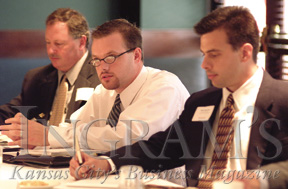
Jacob DiPietro believes that Jackson County’s greatest strength
is its breadth of diversity.

Jeff Pinkerton of Mid America Regional Council
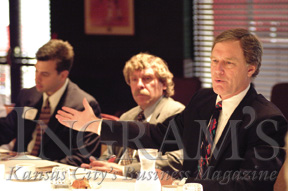
Jim Devine, David Gale and Rich Muller
of Lee’s Summit
Diversity
As many see it, one strength of the county taken as a whole is its diversity,
a diversity not seen in some other metropolitan counties, one in particular
that Jim Harpool describes as "relatively narrow and economically
segregated." Participants were referring here not merely to racial
diversity, but cultural, ethnic, economic and educational as well as
a diversity of work force and housing stock, the kind of diversity that
makes the county attractive to an employer with a large work force.
"That’s what we sell," said Harpool, "and it works."
"This is a diverse county," Jeff Pinkerton affirmed. In marketing
it, he noted, "We have to make sure we are all on the same page."
Jacob DiPietre agreed that "there is much diversity in the county"
and this he sees as its chief asset. Bruce Peshoff added that the county’s
strength was the "wide variety of lifestyles within Jackson County."
As to lifestyles, Tim Underwood noted that in Jackson County one could
choose to live in an urban setting, a newer suburban one or an older
suburban one—"all the opportunities." Said Underwood,
"These are different types of choices that you don’t find
elsewhere in the metro area."
In reference to housing diversity, Missouri Rep. Henry Rizzo noted that
"growth in the older sections was helping out." He referred
specifically to Independence with its "beautiful housing stock"
and the River Market area of Kansas City, whose growth "is going
crazy." These unique options, Rizzo noted, "need to be touted."
Jeff Pinkerton affirmed that downtown living accommodates a wide range
of lifestyles, adding emphatically, "This is a county that provides.".
Work Force
Diversity sells here, too. Jim Harpool noted that the county’s "diverse
work force" appeals greatly to the national retail chains. As participants
acknowledged, however, work ethic matters at least as much as diversity,
and on this count Jackson County scores well again.
"We are the beneficiary of small-town work ethic," said Jack
Craft of the county as a whole. "Our people are well-educated, and
they work hard." "One thing that Jackson County brings to the
table is a job force," added Ron Stewart. "We have the clientele
that can respond."
Eastern Jackson County, in particular, has impressed the employer community.
Jim Devine shared an anecdote about a company that had the opportunity
to recruit from all over the area. The HR director related that work-force
attitudes differed depending on where people come from, but that the work
ethic was "amazing" in Eastern Jackson County, the further east
the better.
Quality of Life
When asked to cite the county’s essential virtue, one participant
after another settled on the phrase "quality of life" and then
tried to define it.
"The way to market the county in its entirety is through its quality
of life," Phil Tate observed. Tate described it roughly as the "enormous
good feeling here in Kansas City. You have to get people here to see it,
feel it and touch it." He then added a refrain often heard in local
development circles, "People who come don’t want to leave."
Mark Martin defined the quality of life in this region as a "function
of the values of the people" and the "untapped potential of
the land and the infrastructure that is underway."
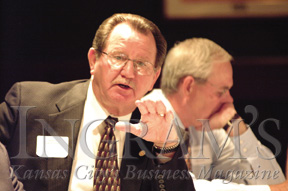
Mayor Ron Stewart of Independence
empasizes the
strength of the county’s workforce.

Grandview Mayor Harry Wilson (right) accompanied
by Jack Craft, Ron Stewart and Tom Riederer
For
Greg Martinette, quality of life rested at least partly in the fact that
"we don’t really have traffic jams compared to other cities."
As a sign of improvement, he cited the reconstruction of the "Lee’s
Summit Triangle." "Formerly known as the Grandview triangle,"
Mayor Harry Wilson of Grandview interjected. "Now that they are improving
the damn thing. . . ," he continued, but his anticipated punch line
was drowned by a room full of laughter. In fact, Wilson wasn’t exactly
joking. The state has quietly changed the name of the once notorious "Grandview
Triangle."
Jim Devine cited the "reverse commute" as one reason for the
relative lack of traffic. A great deal of the county traffic flows west
into Johnson County and not downtown. This is a feature that he and others
actively promote.
One significant and relatively recent contributor to the county’s
traffic quality is the newly completed Bruce Watkins Expressway, which
whisks traffic from Grandview and points south to downtown. As Jack Craft
noted, its delayed development slowed growth in Jackson County as opposed
to Johnson whose highways were built earlier. But the opening, he noted,
"is one reason for increasing development in Jackson County."
Michelle Sweeney also cited its unifying effect on county thinking.
Ron Stewart bypassed definition in favor of a postulate. "Quality
of life," he noted, as though no further elaboration were necessary,
"is something we agree on."
Education
"Great schools," said Jim Harpool
emphatically when asked to describe the county’s virtues, and he
was hardly alone. Jim Devine also cited the county’s schools as a
genuine asset, as did Ron Stewart who praised the "high-quality schools"
in his city, the "outstanding school districts" in the county
and the business-friendly community colleges in his city and county.
But Harpool and the others had ventured into a something of a sensitive
area, the reason being that the public schools of the Kansas City, Missouri
School District are notoriously less than "great." The problem
is compounded because although the district educates but a small percentage
of the county’s students, and not even the majority of the city’s
students, it bears the city’s name. "The hole is so darn deep,"
said David Gale candidly, "that we can’t have [the KCMO school
district] in this conversation until that base comes up to some measurable
level."
David Gale also waxed philosophical about the role of schools as a development issue. "They are good," he said emphatically of the county’s schools, "but I don’t take it further into hyperbole." As he sees it, once the schools meet a "base expectation," other issues come into play.
For Jim Harpool, one area in which Jackson County schools clearly exceed the base expectation is diversity. Although Harpool lives in a neighboring county, his children do not attend school there. As he argued, that county’s schools lack "any kind of diversity whatsoever."
Snergy
"The biggest opportunity we have," noted David Gale, "is to have synergy between areas." In this regard, the county has made notable strides and takes a fair degree of collective pride. Gale, who has developed properties in Canada and in the western United States, observed that the county "enjoys a sophistication in economic development leadership" that is not the norm everywhere. According to Gale, upon reaching critical mass, this sophistication leads to synergy.
Jim Devine, too, cited the group’s "professional experience in economic development" as a major asset for would-be employers. He added, "The group as a peer group works very well together." Rick Muller affirmed that area cities had what he called, "world-class staffs and planning commissions." He also had high praise for the county’s many "public-private partnerships." Fran Owens, in fact, argued that "the willingness of local leadership to forge public-private partnerships" is the county’s foremost strength. This hasn’t been easy. Bruce Peshoff noted the historically "fragmented nature of the county" that he and others have been battling to overcome.
One powerful force for the county over the last 28 years has been Missouri Sen. Harry Wiggins, now being term-limited out. "All these years in Jeff City," he noted, "I’ve tried to promote government partnerships with private sector in the area of economic development" often over opposition.

Jim Harpool discusses the strength
of diversity among
Jackson County’s public schools. Mark Martin and
Tom Riederer look on.
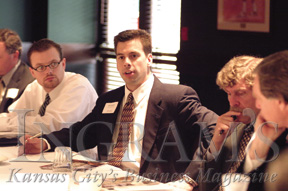
Rich Muller of Summit Technology Campus
emphasizes the
healthy development conditions in Eastern Jackson County

Phil Tate of the Missourie Department of
Economic Development
emphasizes the strong advantages of doing business
in the county and statey.
Although recognizing
the need for even more cooperation, Jim Devine spoke highly of the participants’
efforts in forging the Blue Valley Sewer District. He also cited the "essential"
work of the Mid-America Regional Council, which has helped provide "context"
for many economic development efforts. David Gale echoed this sentiment.
"I think the work that MARC is doing is outstanding," he commented.
He also observed that the Home Builders’ Association has made huge
strides.
"The good news," noted Jim Harpool, "is that we have as
good a group of mayors and economic development directors across the board
as we’ve ever had." According to Harpool, "They all have
a vision, and they are all working to fulfill it."
Harpool was not alone in observing that the vision starts at the top and
"goes from top to bottom." Tom Riederer made the same observation
of Independence’s leadership, citing a "top-down process,"
the most obvious sign of a "marked improvement in the city delivery
of services." Both Riederer and Harpool observed that now, in the
county, developers "may not always get the answer they want, but
they always get an answer." Henry Rizzo applauded their collective
efforts. "The way you sell this county," he confirmed, "is
the aggressive nature of the cities."
Of those cities in question, the consensus was that Lee’s Summit
has created the best environment for economic development. David Gale,
however, rejected the suggestion that Kansas City’s environment was
less accommodating. "Good projects move forward," he argued,
and he cited a few in Kansas City to prove his point.
As to the "local horror stories" of development imbroglios,
Gale claimed that "they are nothing compared to what we see in national
context." The way to avoid such problems and refine the process,
Gale observed, is "through educating the development and builder
community."
The reason for the cooperation, as Jim Harpool observed, was "to get in the game." If the "game" has a great rivalry, it is the one between Jackson County and Johnson County to the west. Although Harpool stressed the need to "increase our batting average," he believed that Jackson County was now fully able to compete.
Phil Tate of the state’s economic development office was grilled as to the state’s ability to offer competitive incentive packages. Although he acknowledged that Missouri is not always as aggressive as Kansas—and that it refrains from raiding Kansas for companies—it has its own competitive edge. "If you compare long-term business climate and tax burden," Tate noted, "you can make more and keep more in Missouri than in Kansas." Tate added that Missouri has a "pro-business" atmosphere, one defined by low taxes and low services.
Henry Rizzo described Missouri as "a very conservative state." Although historically it has not invested enough power in the cities, he noted that "we are getting a lot better at it."
For Jim Devine, that was just the point. "It is easy to talk about what the state is or is not doing," Devine noted, "but I think the purpose of us being here is what are we doing together to make us more competitive." By the "we" he meant the various cities that make up the Jackson County "family."
"That’s all the more reason we can be stronger when we forge partnerships at the local level," Tate added.
There were some, however, who argued that what Henry Rizzo calls "the border mentality" works to the advantage of the area. Ingram’s publisher, Joe Sweeney, was emphatically among them.
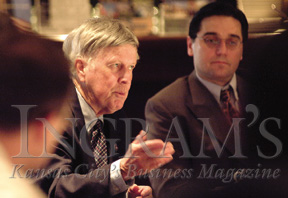
Missouri Senator Harry
Wiggins discusses the enormous economic benefits
associated with the Truman Sports Complex and similar county-based amenities.
Wiggins emphasizes the critical importance to retain strong legislative
support
to area projects and facilitie.
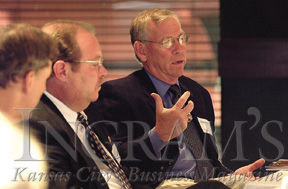
Dennis Watley of the Kansas City Chiefs
dis-cusses opportunities
for Jackson County and the KC area by supporting the renovation
of Arrowhead Stadium. Fran Owens of Blue Springs and
Ingram’s editor Jack Cashill look on.
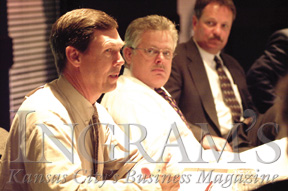
Tim Underwood of Home Builders Association of Greater Kansas City
discusses the exceptional values and healthy growth potential of
Eastern Jackson County
"It would be a challenge to find someplace
as equitably split as this area," Sweeney noted, a split that he
argued "works in favor of the marketplace." "The opportunities
are utterly phenomenal," he added, "if we can just figure out
a way to get along and work together."
"If we can get the state of Missouri and state of Kansas to come
together and develop a strategy where they want to work together equally
like the mayors do," agreed Ron Stewart, "I think a lot of this
will resolve itself."
Bistate
For all the rivalry between the two states, the metropolitan area took
an extraordinarily long stride on the road to cooperation a few years
back when residents of four area counties voted to participate in a bistate
tax to save Kansas City’s venerable Union Station.
"The bistate is the only one of its kind in the whole United States,"
observed Henry Rizzo. "There is some unity there. If we did not have
a vision of a regional concept, we would never have passed the measure
in the first place."
"People thought we would never pass the bistate," said Jack
Craft, one of its principal architects. But what he had discovered in
his extensive research was that local residents, regardless of what side
of the state line they live on, identify themselves as Kansas Citians.
As long as they can control their local schools, the great majority of
them are willing to support an issue even if on the other side of the
state line. As he noted, however, the local political leaders on each
side of the line tend to identify with their specific local jurisdiction.
The prospects for a second bistate levy were dealt a blow when the state
of Missouri failed to pass a critical stadium bill. Dennis Watley of the
Kansas City Chiefs told those gathered just how critical the Chiefs and
the Royals were to the economic life of the county and thanked local political
leaders for their "tremendous effort" in promoting the stadium
bill.
"Anything to preserve the stability of the Royals and Chiefs is worth
a try," Sen. Harry Wiggins observed. But as he noted, and others
confirmed, the bill failed because of opposition to the St. Louis portion
of the bill. Although no longer able to go to the voters with a complete
bistate package, Jack Craft was determined to push forward with Bistate
II. "Our goal is to keep metropolitan Kansas City a major league
town," he insisted, "and the Royals and Chiefs are a big part
of that."
From Mark Martin’s perspective, the single greatest challenge the county faces today is the need "to polish its image." Tom Riederer, among others, agreed. "Getting the message out isn’t easy," affirmed Jim Harpool. But, he added, "It’s getting easier all the time."
"There’s so much positive that can be built upon," affirmed Tim Underwood. "It’s just pulling it together and marketing it.”
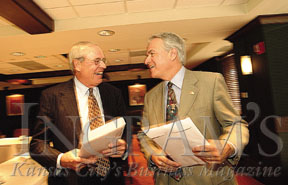
Jack Craft and Phil Tate discuss the
healthy opportunities
for the future of Jackson County